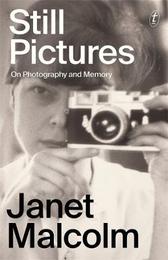
|
Still Pictures: On Photography and Memory
Paperback / softback
Main Details
| Title |
Still Pictures: On Photography and Memory
|
| Authors and Contributors |
By (author) Janet Malcolm
|
| Physical Properties |
| Format:Paperback / softback | | Pages:176 | | Dimensions(mm): Height 198,Width 129 |
|
| Category/Genre | Recommended Titles
General Audience
Previous Three Months
Memoirs |
|---|
| ISBN/Barcode |
9781922458735
|
| Audience | |
|---|
|
Publishing Details |
| Publisher |
Text Publishing
|
| Imprint |
The Text Publishing Company
|
| Publication Date |
17 January 2023 |
| Publication Country |
Australia
|
Description
For decades, Janet Malcolm's books and dispatches for the New Yorker and the New York Review of Books poked and prodded at reportorial and biographical convention, gesturing towards the artifice that underpins both public and private selves. In Still Pictures, she turns her gimlet eye on her own life. Beginning with the image of a morose young girl on her way from Prague to New York in 1939, to fitful early loves and her fascination with what it might mean to be a 'bad girl', Malcolm assembles a composite portrait of a New York childhood, one that never escapes the tug of Europe and the mysteries of fate and family. Later, she delves into the world of William Shawn's New Yorker and the infamous libel trial that saw her become a character in her own drama. Written with Malcolm's peerless skill and sharp wit, this memoir from a titan of American letters is unlike any other.
Author Biography
Janet Malcolm (1934-2021) was the author of many books, including In the Freud Archives; The Journalist and the Murderer; Two Lives: Alice and Gertrude, which won the 2008 PEN/Jacqueline Bograd Weld Award for Biography; and Forty-One False Starts, which was a finalist for the 2013 National Book Critics Circle Award for Criticism. She was a frequent contributor to the New Yorker and the New York Review of Books. In 2017, Malcolm received the Gold Medal for Belles Lettres and Criticism from the American Academy of Arts and Letters.
Reviews'What unites these pieces is a mood-heavy, autumnal, nostalgic...There is stirring, beautifully structured writing here, particularly in the title essay, a profile of Fisher, which combines many of the writer's signal interests-our unconscious aggression and the way we methodically and unknowingly recreate the world of our childhood in our adult lives.' * New York Times on Nobody's Looking at You * 'Janet Malcolm...remains a ruthless, dazzling journalist.' * Guardian on Nobody's Looking at You * 'With no weak selections and several strikingly prescient ones, this collection shows its author as a master of narrative nonfiction.' * Publishers Weekly on Nobody's Looking at You (starred review) * 'Malcolm as a whole sets a gold standard of performance for any journalist...It's wise to expect the unexpected.' * Australian on Nobody's Looking at You * 'Nobody's Looking At You is brimful of all the eloquence, erudition and insight a thoughtful reader could want.' * NPR on Nobody's Looking at You * 'A powerfully distinctive and very entertaining literary experience.' * New York Times on Forty-One False Starts * 'Forty-One False Starts is a remarkable and, in its strange way, gripping piece of work. It achieves the rare feat of communicating something valuable about the largely ineffable "creative process."' * Zoe Heller, New York Review of Books on Forty-One False Starts * 'This is a well-laid challenge to readers to open their eyes to how they read, and how to judge.' * Independent on Forty-One False Starts * 'No living writer has narrated the drama of turning the messy and meaningless world into words as brilliantly, precisely, and analytically as Janet Malcolm...Her influence is so vast that much of the writing world has begun to think in the charged, analytic terms of a Janet Malcolm passage.' * Paris Review on Forty-One False Starts * 'Superb...[The] final, splendid, most personal work of her long career.' * New York Times * 'These [Still Pictures] essays are a radical departure from everything else Malcolm wrote over the course of her career: they concern people, places, and items that populated her younger life...She used her journalistic work to explore her own mind, especially some of its more submerged corners...She knew better than most that the only thing scarier than writing about oneself is letting someone else wrest control of the narrative.' * LitHub *
|